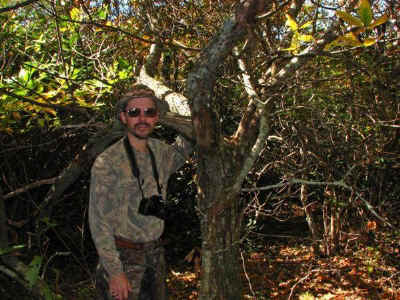American Chestnut Project
|

(above) American Chestnut leaves from
Pisgah National Forest, NC. (right)James Parton with an
American Chestnut tree, near Mount Pisgah, NC. |

|
On March 14, 2010 The Eastern Native Tree
Society and Western Native Tree Society switched from discussion lists
on Google Groups to a new discussion list in a Bulletin Board format at:
http://www.ents-bbs.org/index.php
Posts made since the inception of the BBS on march 14, 2010 will be
sorted and archived on the BBS. Click on the link above to go to the
equivalent section on the new BBS. This website will continue to serve
as a front end for the ENTS and WNTS groups. It will continue to serve
as a repository of older posts, and will serve as the host site for
special projects and features that are not well suited for a BBS format.
Please visit the BBs for the latest information and trip reports.
American Chestnut Project
A famous American poem written by Henry
Wadsworth Longfellow (1841) begins: Under the spreading chestnut tree, the
village smithy stands." The words evoke a scene of the great
chestnut trees found here in the eastern United States in the mid 19th
century However since these words were penned, the
American Chestnut (Castanea dentata) has been reduced to occasional
specimens growing as root sprouts as a result of Chestnut Blight (Cryphonectria
parasitica), a Chinese fungal parasite introduced into the American
population in the early 1900's. By the late 1930's a species that
once compromised almost 25% of the tree populations in the Appalachians
was all but gone from its entire range in the eastern United
States.
Present day specimens rarely reach 20
feet in height, before succumbing to the the still virulent chestnut
blight. larger specimens are rare and are sought out by groups such
as The American Chestnut Foundation http://www.acf.org/
and the American Chestnut Cooperators Foundation http://ipm.ppws.vt.edu/griffin/accf.html
are actively seeking out these larger specimens as a source of genetic
material and seed in attempts to someday restore the American Chestnut
populations. In areas of the western United States and Canada
pockets of isolated trees and planted specimens still flourish where the
pathogen is not present. A once isolated pocket in Wisconsin has
recently been reached by the blight and is succumbing to the infection.
James Parton (photo above), a member
or Easter Native Tree Society and a member of the American Chestnut
Foundation, has initiated the ENTS American Chestnut project to compile and
coordinate the efforts of ENTS members to document the remaining large
specimens of American Chestnut and related species, to document historical
information on the species, and to encourage further research on the
species. This section of the website will serve as the portal for
the information collected as part of this project.
 Castanea General Information
Castanea General Information
 Chestnut Blight
Chestnut Blight
 Historical Accounts
Historical Accounts
ENTS
Field Trips and Discussions
-
Chestnut rampicks Rampick
is Norse (I think...the term was shared by my brother, who studied dead
languages.) for snag. The Norse were among the ancient Europeans who
worshipped great trees. I think the word sounds appropriately reverent
for these rare historic relics, the ghosts of American chestnut trees
long dead. Go have a look. We are the last generation to see what
remains of the ancient ones, until a cure comes, and a few centuries
pass...January 8. 2010
- Chestnuts on the Appalachian Trail
http://groups.google.com/group/entstrees/browse_thread/thread/17410e64d23058a5?hl=en
-
Chestnuts in Montgomery Co PA
 Nov
2008 Nov
2008
- Chestnut Grove Hominy Valley Overlook BRP
 Nov 2008 Nov 2008
- A Parkway Ride NC
 Nov 2008 Nov 2008
- Chestnuts in Big Ivy
 Oct 2008 Oct 2008
- BRP Destinations Centers American Chestnut Display
 Oct 2008 Oct 2008
- More Pisgah Chestnuts NC
 Oct 2008 Oct 2008
- American Chestnut Find in SE PA
Aug 2008
- Chestnut Photos Randy Brown
 July
2008 July
2008
- Wisconsin American Chestnuts
 July 2008 July 2008
- American Chestnut Project
 June 2008
June 2008
- Pisgah Chestnut Hunt,NC
 June 2008
June 2008
- Pink Bed loop Trail, PNF, NC
 June 2008 June 2008
- Chinese Chestnuts Hendersonville NC
 June 2008 June 2008
- Mt
Jefferson Natural Area NC
 May 2008
May 2008
- Big
Ivy Chestnuts NC
 May 2008 May 2008
- Ohio Chestnut March
2008
- Paris
Woods, Dana, NC (chinkapins)
 Dec 2008
Dec 2008
- Devil's
Courthouse, Blue Ridge Parkway, NC
 Oct 2007
Oct 2007
- Pisgah
Chestnuts, NC
 Oct 2007 Oct 2007
- Veterans
Cemetery, Black Mountain, NC
 Oct 2007
Oct 2007
- American
Chestnuts at Victor Fields, NC
 Oct 2007
Oct 2007
- American
Chestnut Discussion Aug - Sept 2007
- Old
Chestnut Stump - Potters Mills, PA
 March 2007
March 2007
- Chestnut Notes
March 2007
- Chestnut
Ridge, ANF, Pa
 Sept 2006
Sept 2006
- American
Chestnut update - Cook Forest, PA
 Aug 2006
Aug 2006
- American
Chestnut Blight Resistance/Virulence July 2006
- American
Chestnut Book March 2006
- Clear
Creek State Forest Chestnut
 Oct 2005
Oct 2005
- Southeastern
PA Chestnut: Deer Climber damage
 Sept 2005
Sept 2005
- Two
trips to Cook Forest Aug 2005
- American
Chestnut, Brockway, PA - Gallery
 July
12, 2005
July
12, 2005
- American
Chestnut (Castanea dentata) Species Page

- Allegheny Chinkapin (Castanea
pumila) Species Page

External Links
and Accounts
|